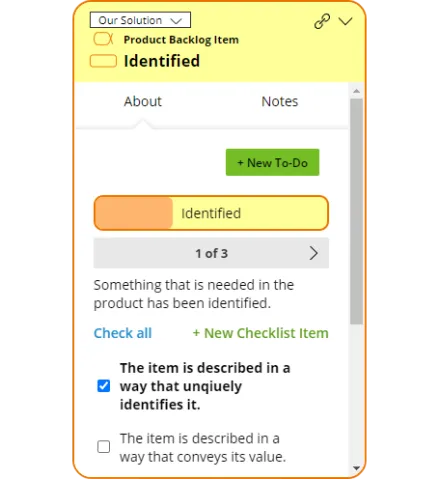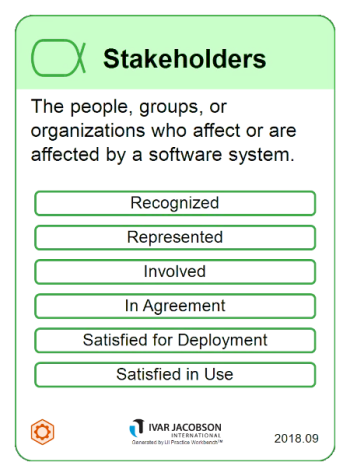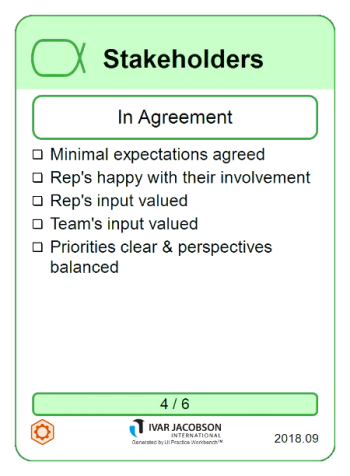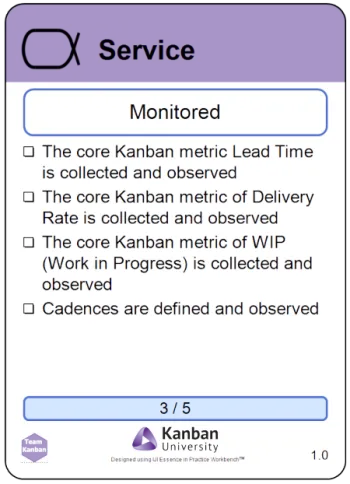Introduction
This article explains how to track progress of an endeavor using the Essence standard and the key concept of Alphas. If you are new to Essence and reading about these ideas for the first time, we recommend first looking at our Introduction to Essence found here.
It is important to say up front, that the Essence standard has grown from dealing with the challenges inherent in the software development world. That said, the paradigm shift introduced with a cleverly engineered separation of concerns between the things you are trying to progress (Alphas) and the set of activities you might undertake to progress them (Practices), is super super cool and can be applied to pretty much any human endeavor. So, if you are musing on a way the track the progress of some important endeavor, (whatever that may be), read on and enjoy!
This article follows the Measuring Progress video that can be viewed below.
Video Summary
Essence to Track Progress – an innovation
Progress tracking is one of the real innovations within Essence, something that’s very different from how we normally think. To get the best of the idea, it really requires a bit of a pivot in mindset.
States
The pivot is around how we think about measuring progress today. Essence measures progress by ‘state’. We need to identify the things that we want to measure the progress of, Essence calls those things ‘Alphas’, these are simply the big things that you care about, like your requirements or your stakeholders for instance. Each of these Alphas has a number of states that you need to work your way through. What is important in terms of measuring progress is not how much work you’ve done to get through those states, it is which state you are actually in now. With Essence, it is the state that you are in that matters, irrespective of the amount of work that it took to achieve that state.
This is very different from how we often think about measuring progress or measuring the amount left to do. We typically think about how much work we have done, or how much work we think is remaining, or how much time we’ve spent, or how much time we think is remaining. I am sure we have all done that in the past right? We have all seen projects where somebody asks, “How far through the project are we?” and the answer is, we’re 80% of the way through and we know that because of all the tasks that we thought we would need to do to complete the job, we’ve done 80% of them and we’ve got 20% left. We have also all probably heard the phrase the last 20% of the project takes 80% of the time, and that’s because it’s typically true. That is because humans are very bad at measuring time and we’re also very bad at responding to change. So when we get to that last 20% of tasks, they take longer, but more importantly, they are often not the last 20% of tasks at all - there are many more tasks required in addition, before we can really say that we are complete.
So even when we try very hard to analyze well, we’re always going to make these mistakes and that’s why measuring progress by time or by work doesn’t work very well. This is why Essence doesn’t do that, instead, we look at measuring state to show us what progress we’ve made.
To give an example, we care about the collective state of the stakeholders of our endeavor (whatever that endeavor may be). Figure 1 shows the various states through which the stakeholders will need to be progressed.
FIGURE 1: THE STAKEHOLDERS ALPHA STATES
Checklists
So how do we know what state we’re in and how do we know that we have achieved a particular state?
Well, that’s where Essence helps us with checklists. Checklists are interesting because they can feel a little bit obvious but they are also incredibly powerful and used widely in all sorts of industries. One great example is a pre-operative checklist used in hospital operating theatres. In a study in Michigan, many operations were going wrong because of simple things like, not putting on the right PPE, or working on the wrong patient or not washing hands properly. All really basic things, but when you introduce a physical checklist and you ask the surgeon to tick each of the items off, the study found they were done every time. Whilst clearly, surgeons are incredibly bright people doing very complicated work, it took a humble checklist to make sure the obvious basic things were not getting forgotten.
That is why checklists are really important because they help us stay honest, they help us do the basic things as well as the more complex things, and they force us to check that we’ve actually done something before we can say that that progress has been achieved. Figure 2 shows some example checks associated with the Stakeholders Alpha mentioned above. They define what it means to be in the “In Agreement” state.
FIGURE 2: AN EXAMPLE CHECKLIST
Instead of simply making an arbitrary judgement about “In Agreement”, the checklist gives us some concrete questions to focus on. So, for instance, are the stakeholder representatives happy with their involvement, are their inputs valued by the team? These things will require some investigation in order to faithfully check.
Leading and Lagging Indicators
States and Checklists are extremely important and powerful concepts, and the reasons for that come back to the difference between how we do things in Essence and how things are more traditionally done.
You have probably heard of the terms: leading and lagging indicators. Leading indicators help us identify risk and potential problems (and potential successes), before they become issues. So they give us advanced warning of something.
The problem with measuring task completion and time spent (for instance) is that they’re not leading indicators, they’re lagging. I.e. we can’t measure them until after they’ve happened, so we already know that we’ve spent the time when it is measured. Before, we don’t know exactly how much time that we are going to spend. That is a problem, because it means that typically we don’t find out about risk until it’s closer to being an issue.
States and checklists are leading indicators. Figure 3 shows an example of what is meant by that. Shown is the ‘Service’ alpha checklist from the Team Kanban Essentials practice in the monitored state. One of the indicators is that ‘The core metric Lead Time is collected and observed’. Now let’s say that we haven’t ticked that check. The Service might be running just fine, but if we’re not collecting the metrics, we might not know when it stops being fine. We won’t be able to adjust the flow and that might result in work staying in our system longer than it should making the Lead Time increase - and that isn’t what we want. Whereas if we do monitor and collect those metrics then we’ll spot little changes in the wrong direction before they become a big problem. That lets us adjust, to bring them back to where we want to, or perhaps adjust expectations. It might be our Lead Team is getting longer and that’s important to share with my stakeholders.
FIGURE 3: CHECKLIST OF THE SERVICE ALPHA MONITORED STATE FROM THE TEAM KANBAN ESSENTIALS PRACTICE
A second example is based on the Stakeholder Alpha ‘In Agreement’ state checklist shown in Figure 2 above. Are all the stakeholder representatives still happy? This is another really important thing with measuring progress with states… states are ‘additive’. So to be in the third state or the fourth state, it depends upon the other states still being true. So if I want to get to state five, for example with stakeholders, I need to go back and check that state four is still true and three and two and one. If any of those have stopped being true. Then that’s a leading indicator I might have a risk.
So let’s say we are checking state five or six and we go back and check state four, and we realize the stakeholder representatives are no longer happy with their involvement. Well, what might happen as a result? Maybe the quality of their input is not as good as it was and they stop attending all the meetings? Maybe they care less about the quality of the product and what we thought we getting from them we are no longer getting. So things will go wrong that they would have noticed before. Because they are less involved, we might not notice those things being an issue until somebody else comes along at the end - maybe to accept the system - and they say ‘No, that’s not good enough’.
So we can see that identifying these things early can give us advance warning of issues and problems that we’ll see in the future. That is why using states and checklists as a measure of progress isn’t just a better way to measure progress, (because you’re measuring actuals and outcomes rather than inputs like work and time), but they also give you really powerful leading indicators of change, of risk and potentially of success as well.
In summary, a big part of Essence is thinking differently about how we track progress… states and checklists are the way to do it!
Further reading
- Watch the rest of our Essence introductory videos here.
- Our Essence Home Page is a good place to start if you are new to Essence.
- To get going with the approach, you will need a set of Alpha State Card Download to play with.
- The Alpha State Games Guide Download will give you some further ideas on how to utilize the Alpha State Cards
- We have some great Tools to bring Essence to life and help you track progress.




